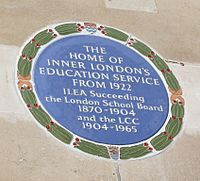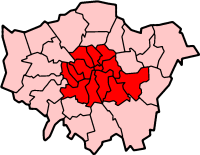Inner London Education Authority facts for kids

Plaque on London County Hall
|
|

Boroughs within the Inner London Education Authority Area
|
|
| Abbreviation | ILEA |
|---|---|
| Predecessor | London County Council |
| Successor | 12 Inner London borough councils and the City of London Corporation |
| Formation | 1 April 1965 |
| Dissolved | 1 April 1990 |
| Type | Local education authority |
| Legal status | Special committee (1965–1986) Body corporate (1986–1990) |
| Headquarters | London County Hall |
| Location |
|
|
Region served
|
Inner London |
|
Membership
|
58 directly elected members (1986–1990) |
|
Parent organisation
|
Greater London Council (1965–1986) |
The Inner London Education Authority (ILEA) was a special group in charge of schools and learning for children in Inner London. It looked after education in the City of London and 12 areas called Inner London boroughs. ILEA existed from 1965 until it was closed down in 1990.
From 1965 to 1986, ILEA was a committee of the Greater London Council (GLC). Then, on April 1, 1986, it became its own separate group. People in Inner London could directly vote for its members.
Contents
History of ILEA
The Inner London Education Authority was created in 1965. This happened when the Greater London Council (GLC) took over from the London County Council (LCC). The LCC used to be the main local government for London.
The LCC had been in charge of education in Inner London since 1904. Before that, the London School Board handled schools. In areas that became Outer London, local councils managed education.
Why ILEA Was Formed
In 1960, a report suggested creating the Greater London Council. It also said that the GLC and London boroughs should share control over education. The GLC would plan schools, and boroughs would manage them daily.
However, the government did not agree with this part of the report. Councils in Outer London wanted more control over their own schools. Teachers and other groups also did not want the LCC's education system to be split up.
So, the London Government Act 1963 created ILEA. ILEA took over the LCC's education duties. Outer London boroughs were given their own education powers. ILEA was first meant to be a temporary group. But in 1965, the Labour government made it a permanent body.
ILEA's Unique Status
ILEA did not cover a small area called North Woolwich. The LCC had a secondary school there. This area moved to the new London Borough of Newham in Outer London. So, Newham Council became its own education authority.
ILEA had a special legal setup. The GLC was technically the education authority for Inner London. But it was hard to let GLC members from Outer London have a say in Inner London schools. So, the GLC gave its education duties to ILEA.
ILEA was a 'special committee'. It included GLC members from Inner London. It also had one member from each Inner London borough and the City of London. People who were part of both the GLC and ILEA often focused on just one job.
Political Leadership and Decisions
It was possible for ILEA to have more members from the Labour Party. This could happen even when the GLC had more members from the Conservative Party. This occurred from 1970 to 1973 and from 1977 to 1981.
Most important decisions at ILEA were made by its Education Committee. Every member of ILEA was on this committee. The committee could also add members who had experience in education. Some of these members represented teaching unions.
Changes in Leadership
In 1964, ILEA started with 43 Labour members and 9 Conservatives. There was also one Independent member. After the 1967 election, the Conservatives won more seats. Christopher Chataway became the Leader.
However, Labour gained control again in 1970. Ashley Bramall then became the Leader for a long time. During his time, ILEA changed to a system of comprehensive education. This meant all students went to the same type of school. He also ended school corporal punishment (physical punishment in schools). He stayed in power even after the Conservatives won the GLC elections in 1977.
After the 1981 elections, Ken Livingstone and the Left wing won control of the GLC. Bramall lost his leadership position in a Labour Party vote. Bryn Davies took his place. Livingstone later said he regretted this decision. He admired Bramall's leadership skills. In its final years, ILEA had several Left-wing leaders. None of them stayed long or became very well known. Frances Morrell led ILEA from 1983 to 1987. She was followed by Neil Fletcher.
Leaders of ILEA
The position of Leader of ILEA started in April 1967. Before that, the leadership was shared. James Young was Chairman of the Education Committee. Harold Shearman (1964–1965) and Ashley Bramall (1965–1967) were Chairmen of the Authority.
Here are the Leaders of ILEA from 1967:
- Christopher Chataway (1967–1969)
- Lena Townsend (1969–1970)
- Ashley Bramall (1970–1981)
- Bryn Davies (1981–1983)
- Frances Morrell (1983–1987)
- Neil Fletcher (1987–1990)
Special Services and Centres
ILEA offered many services beyond just running schools. It had its own television service for schools. This was called the Educational Television Service. It was based in the former Tennyson Secondary School in SW8.
The television centre had two working TV studios. It also had a training studio and control rooms. At one point, it was thought to be the largest closed-circuit television system in the world. The first broadcast was on September 16, 1969. The Television Service ran until 1977.
When the Post Office stopped providing cables for distribution, the programs moved to VHS tapes. The TV network then closed down.
Arts and Sports Centres
The Cockpit Theatre, Marylebone was built for ILEA in 1969–70. It is located in Gateforth Street, London, NW8. Edward Mendelsohn designed it as a Theatre in the round.
ILEA created the first Theatre in Education company to be fully based within a local education authority. It hired seven actor-teachers and a stage manager. Their work focused on secondary schools and further education. The Cockpit team used theatre to help students understand school texts. When ILEA closed in 1990, the theatre was given to the London Borough of Westminster.
ILEA also managed a watersports centre. This was located at Greenland Dock in Bermondsey. It also ran the Centre For Life Studies. This was a training centre for biology teachers. It was located at London Zoo.
ILEA also helped fund two museums. These were the Horniman Museum in Forest Hill, south London. The other was the Geffrye Museum, now called the Museum of the Home, in Bethnal Green.
ILEA Becomes Independent
The Local Government Act 1985 changed ILEA. It made ILEA a standalone group. It became an authority that people could directly vote for. This new group started before the old committee of the GLC was abolished.
It was first known as the Inner London Interim Education Authority. It officially took over its powers on April 1, 1986. In the May 1986 elections, each Inner London area elected two members to ILEA. The Labour Party won easily.
Why ILEA Was Abolished
ILEA had already stopped one attempt to close it down in 1980. In 1983, the government announced it would abolish the GLC. This led to another attempt to get rid of ILEA. However, the Inner London Boroughs were not ready to handle education services on their own.
The Conservative government was led by Margaret Thatcher. She had disliked ILEA since the early 1970s. She thought it spent too much money and had too many rules. She wanted to abolish it.
Conservative Members of Parliament (MPs) continued to oppose ILEA. Kenneth Baker proposed a new law called the Education Reform Bill. This bill would allow boroughs to leave ILEA and become their own education authorities.
However, the government was forced to act faster. An amendment was proposed in the House of Commons by Norman Tebbit. It was supported by Michael Heseltine. This amendment called for ILEA to be abolished completely. This was surprising because Tebbit and Heseltine had very different political ideas. It also caused some local debate. Both MPs represented areas outside the ILEA region.
On February 4, 1988, the government announced it would accept the amendment. ILEA would be abolished in 1990 as part of the Education Reform Act 1988. Once the law was passed, ILEA cooperated with the decision. The Inner London boroughs then became their own education authorities. They still are today.
The end of ILEA meant that Inner London boroughs had to create their own rules for school admissions. This also affected school admissions across the country. A court decision in 1989, known as the Greenwich Judgement, ruled that local education authorities could no longer give their own residents first choice for schools.

